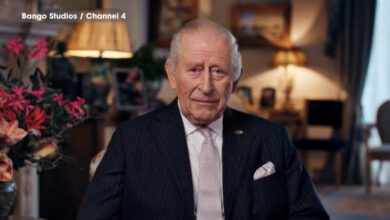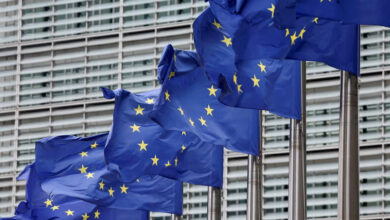
The president said “relevant counteroffensive defensive actions are taking place in Ukraine” but remained tight-lipped about the details.
There has long been speculation of a Ukrainian counteroffensive, not least as it has been talked up by Ukrainian officials.
But the idea of a counteroffensive may be misleading, giving the impression that there was a discrete before and after period of the campaign.
In reality, Ukraine has been softening up Russian forces for months and is already engaged in efforts to recapture territory. What’s more, as Ukrainians are keen to emphasize, the actions of their armed forces are in response to an invasion.
That is why Ukrainian officials like to stress – as Zelensky did with his careful form of words Saturday – that all their actions should be seen as defensive.
Despite all this, the conflict is entering a new stage, and one which may decide its ultimate outcome. Here are some of the factors at play.
Look to the south
Unlike the fluid opening months of the conflict, when Russia attempted to seize the Ukrainian capital Kyiv and other major cities, the frontline in Ukraine is now settled in the south and east.
That also means, as Ukrainian officials acknowledge, the new campaign won’t have the element of surprise, such as during last September’s sweep through the Kharkiv region.
After retaking Kharkiv and Kherson, the southern Zaporizhzhia region will likely be a main focus for the Ukrainian army. It has been stepping up activities there this month.
Gains for Ukrainian forces in Zaporizhzhia could strike a major blow to Russia’s wider campaign. It is seen as a primary objective for Ukraine to break Russia’s land corridor from occupied Donbas to Crimea, which was illegally annexed in 2014.
In terms of its goals, Kyiv has consistently said that it wants to recapture all of the territory controlled by Russia.
In an address earlier this year Ukrainian President Volodymyr Zelensky said that included Crimea.
“It is not an intention, it is our land. Crimea is our sea and our mountains,” Zelensky said.
Whether that goal is achievable remains a huge open question.
Russia has dug in – but is vulnerable
Ukraine’s counteroffensive has long been expected by Russia, giving Putin’s army several months to prepare the ground and build an elaborate array of defenses.
Satellite imagery shows the extent of Russian fortification. These include layers of anti-tank ditches, obstacles, minefields and trenches.
Such defenses stretch for hundreds of miles across the meandering front. Breaking through them will prove difficult.
Ukrainian officials have frequently relayed accounts from people in occupied areas such as Mariupol and Berdiansk of long Russian convoys passing through and dozens of buildings being appropriated as military accommodation.
Ukraine has been carrying out so-called shaping operations to lay the groundwork for its offensive, disrupting Russian supply lines, destroying ammunition depots and targeting fuel infrastructure.
Adding to this, there have long been reports of Russian infighting, with particular friction between the Wagner mercenary group and Kremlin military leadership.
Russia’s small gains, especially compared to Putin’s initial ambitious targets in the war, have come at huge cost, decimating frontline units and starving many of manpower, as well as critically important experience.
Bakhmut is still in play
Despite Wagner claiming victory in the eastern city of Bakhmut and handing it back to Russian forces, the city remains a flashpoint.
The city’s fall was a rare gain for Russia but recently Ukraine’s forces say they made limited progress recapturing land to the northwest and southwest.
Ukraine may be using the city to weaken Russia elsewhere by diverting its resources, which similarly may have been the aim of raid by Russian dissident fighters in their home country.
While there are no official figures, it is clear taking Bakhmut came at a huge cost for Russia.
NATO intelligence estimates that for every Ukrainian soldier killed defending Bakhmut, Russian forces lost at least five.
Ukraine has new weapons at its disposal
Ukraine upgraded its weaponry ahead of the counteroffensive.
The United Kingdom delivered multiple “Storm Shadow” cruise missiles to Ukraine, giving the nation a new long-range strike capability.
With a firing range in excess of 250km, or 155 miles, it is just short of the 185-mile range capability of the US-made surface-to-surface Army Tactical Missile Systems, or ATACMS, that Ukraine has long asked for.
Ukraine has also received at least two Patriot systems, one from the United States and one from Germany, to enhance its air defenses, which have previously been unable to intercept more modern Russian missiles.
Proving its new prowess last month, Ukraine for the first time used a US-made Patriot air defense system to intercept a Russian hypersonic missile, marking a potentially pivotal moment in the conflict.
In addition to military equipment, the US announced a $1.2 billion aid package to Ukraine to support the launch of its counteroffensive.
The clock is ticking
A question mark hangs over how long the international support for Ukraine will last.
Next year’s US election looms, and comments made by ex-president Donald Trump during a CNN Town Hall raised the possibility that the so far strong US support for Ukraine could end.
During the meeting Trump refused to say whether who he wanted to win the conflict, saying instead he wanted “everybody to stop dying.”
The longer the war goes on, the more likely divisions are to grow among Ukaine’s allies, something that will play to Russia’s advantage.
If the war ends in negotiations or stalemate, Ukraine will want an upper hand. It will be seeking to make as many gains as it can from the counteroffensive, and fast.




